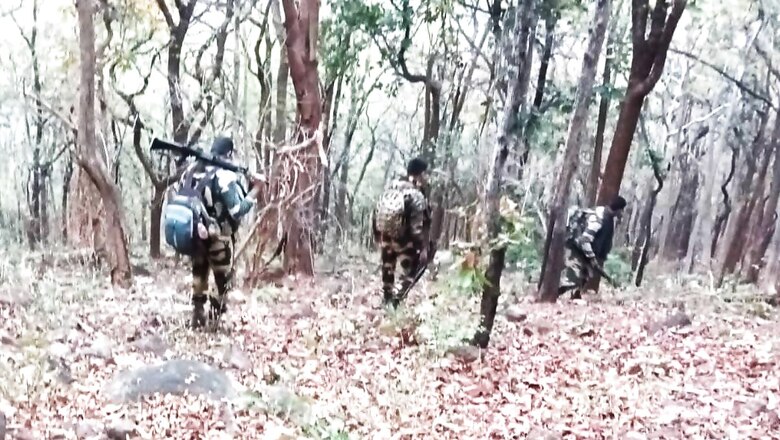
views
The 29 Naxals killed in Chhattisgarh’s Kanker on Tuesday is the highest number of Maoist cadre eliminated since 2021 when Gadchiroli Police gunned down 26 ultras, including the dreaded Milind Teltumbde.
Tuesday’s operation, which came just two days before first phase of Lok Sabha polls, may have successfully averted a major Naxal strike. Both Union Home Minister Amit Shah and chief minister Vishnu Deo Sai called the operation historic.
The killed Naxals are believed to be hard-core guerrillas who are part of dreaded Maoist Hidma’s Battalion 1.
“Of the 29 bodies recovered, 28 are in People’s Liberation Guerrilla Army (PLGA) uniform. This clearly means that these were not over-ground workers or villagers supporting Naxals. These were armed militia members,” a senior Border Security Force (BSF) officer told News18.
The success is being seen as the culmination of a number of steps taken by the Centre as well as state agencies in the last few months.
Setting Up Camps
Eight camps have been set up in Kanker by BSF in the last four months, three of which are new camps. The scene of operation on Tuesday was about 12 kilometres away from the BSF Company Operating Base.
“As CRPF tightened the noose in Bijapur and Sukma, our assessment was that Naxals would relocate to Abujmad-Narayanpur, Kanker. New deployment was done keeping this in mind,” a BSF officer said.
Specific Intelligence
A police officer in Chhattisgarh told News18 that over the last three months, Intelligence agencies have kept an eye on the Abujmad area.
On Tuesday, BSF received a specific tip-off that military company number 5 of PLGA was in the jungles of Chhottebetiya. At around 2pm, contact was established. Officials said the first fire came from the Naxal side, injuring a BSF inspector and two others. Retaliation from District Reserve Guard (DRG) and BSF led to at least 29 ultras being killed, including DVC commander Shankar Rao and Lalita who were carrying a reward of Rs 25 lakh on their head.
“We suspect they were caught off guard. Perhaps they were having lunch or resting when the combined forces swooped on them,” an officer posted in the area said.
Crackdown on recruitment and arms
State and central government incentives, anti-Naxal operations and setting up of camps have had a combined effect on cadre recruitment, as per the assessment by central agencies. With new cadre not joining them, the strength of CPI Maoist has depleted. The banned ultras have also suffered a setback in terms of seizure of their arms and ammunition.
On Tuesday, a huge cache of arms — including three AK-47 rifles, INSAS/SLR/Carbine/.303 rifles, and huge quantities of arms — were recovered from the spot.
“In 1996, and then again in 1998, local thanas, just kilometres away from Tuesday’s area of operation, was looted by Naxals. This year too, they tried to loot a CRPF party but were thwarted. No recruits and depleting arms mean Naxal strength is fast reducing,” a police officer in Chhattisgarh told News18.
Mobile and road penetration
With each new camp, the Union government has ensured mobile towers are set up deep inside Chhattisgarh’s forests.
News18 met villagers in Dantewada who do not have electricity but use a battery to charge their mobile phones. This mobile penetration and fascination of youngsters with phones has been used by forces to their advantage. Naxals have issued diktats in many areas against the use of mobiles, realising that information about their presence in the interiors is now travelling faster to the police.
Road construction has meant forces are moving swiftly as soon as a tip-off is received. On Tuesday, the 12-kilometer journey by DRG and BSF from CoB to Binagunda-Koragutta jungles was covered in no time, officials said.
Better and real-time coordination
A committee has been set up for better coordination of anti-Naxal operations. Headed by the state DGP, the weekly meetings of the committee are meant to plan operations, assign specific roles and iron out roadblocks. The Union Home Secretary has also reviewed meetings of the committee, which has DGs of CRPF, BSF, ITBP, state police, senior paramilitary and intelligence officials as its members.
Home Minister Amit Shah, at an election rally in Chhattisgarh this week, said Naxalism will be over in three years. Paramilitary officials who spoke to News18, however, expressed hope that at the rate that operations and anti-Naxal steps are being taken, Maoism could be on its last leg in 2024 itself.


















Comments
0 comment